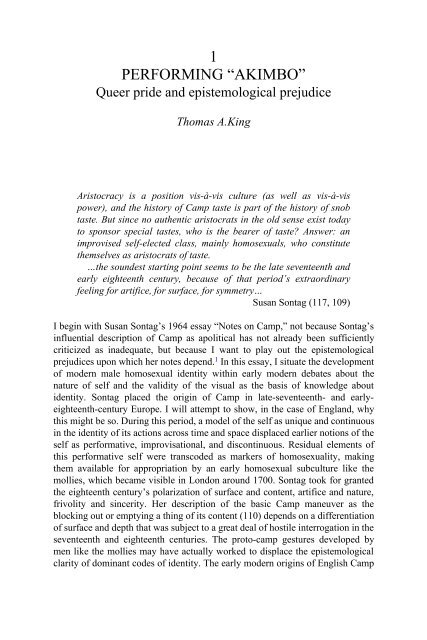Edited by Moe Meyer - Get a Free Blog
Edited by Moe Meyer - Get a Free Blog
Edited by Moe Meyer - Get a Free Blog
You also want an ePaper? Increase the reach of your titles
YUMPU automatically turns print PDFs into web optimized ePapers that Google loves.
1<br />
PERFORMING “AKIMBO”<br />
Queer pride and epistemological prejudice<br />
Thomas A.King<br />
Aristocracy is a position vis-à-vis culture (as well as vis-à-vis<br />
power), and the history of Camp taste is part of the history of snob<br />
taste. But since no authentic aristocrats in the old sense exist today<br />
to sponsor special tastes, who is the bearer of taste? Answer: an<br />
improvised self-elected class, mainly homosexuals, who constitute<br />
themselves as aristocrats of taste.<br />
…the soundest starting point seems to be the late seventeenth and<br />
early eighteenth century, because of that period’s extraordinary<br />
feeling for artifice, for surface, for symmetry…<br />
Susan Sontag (117, 109)<br />
I begin with Susan Sontag’s 1964 essay “Notes on Camp,” not because Sontag’s<br />
influential description of Camp as apolitical has not already been sufficiently<br />
criticized as inadequate, but because I want to play out the epistemological<br />
prejudices upon which her notes depend. 1 In this essay, I situate the development<br />
of modern male homosexual identity within early modern debates about the<br />
nature of self and the validity of the visual as the basis of knowledge about<br />
identity. Sontag placed the origin of Camp in late-seventeenth- and earlyeighteenth-century<br />
Europe. I will attempt to show, in the case of England, why<br />
this might be so. During this period, a model of the self as unique and continuous<br />
in the identity of its actions across time and space displaced earlier notions of the<br />
self as performative, improvisational, and discontinuous. Residual elements of<br />
this performative self were transcoded as markers of homosexuality, making<br />
them available for appropriation <strong>by</strong> an early homosexual subculture like the<br />
mollies, which became visible in London around 1700. Sontag took for granted<br />
the eighteenth century’s polarization of surface and content, artifice and nature,<br />
frivolity and sincerity. Her description of the basic Camp maneuver as the<br />
blocking out or emptying a thing of its content (110) depends on a differentiation<br />
of surface and depth that was subject to a great deal of hostile interrogation in the<br />
seventeenth and eighteenth centuries. The proto-camp gestures developed <strong>by</strong><br />
men like the mollies may have actually worked to displace the epistemological<br />
clarity of dominant codes of identity. The early modern origins of English Camp


